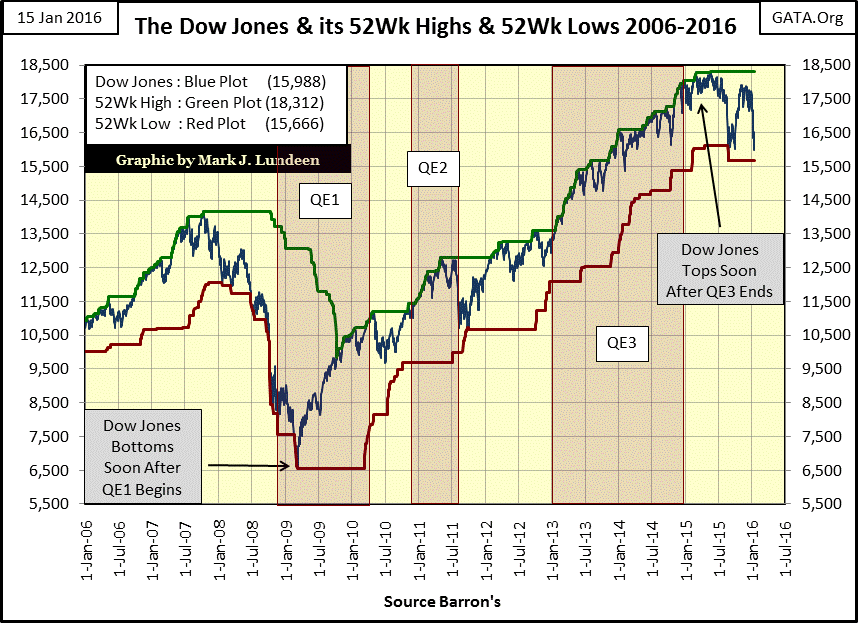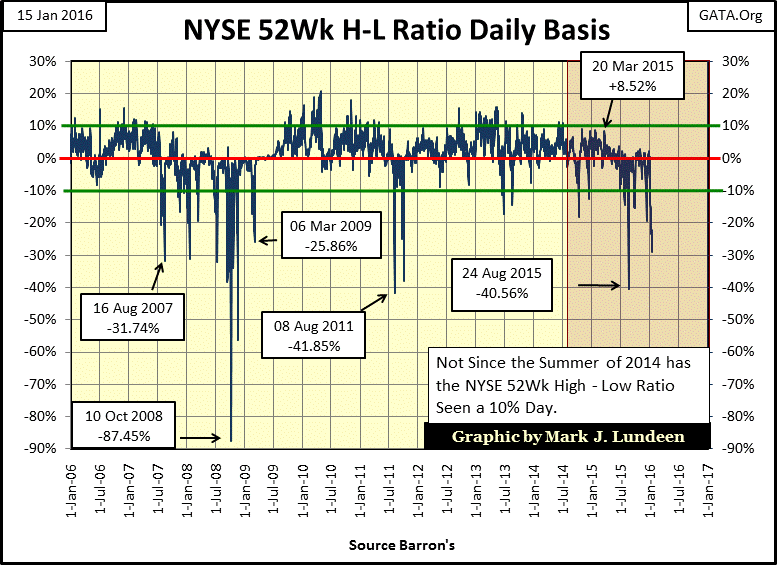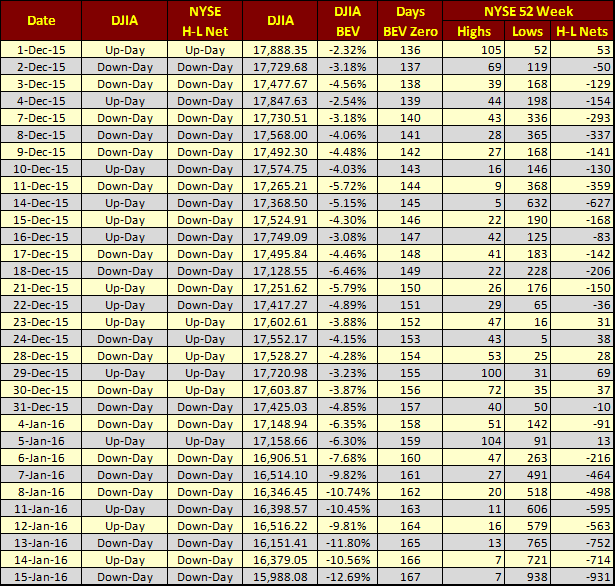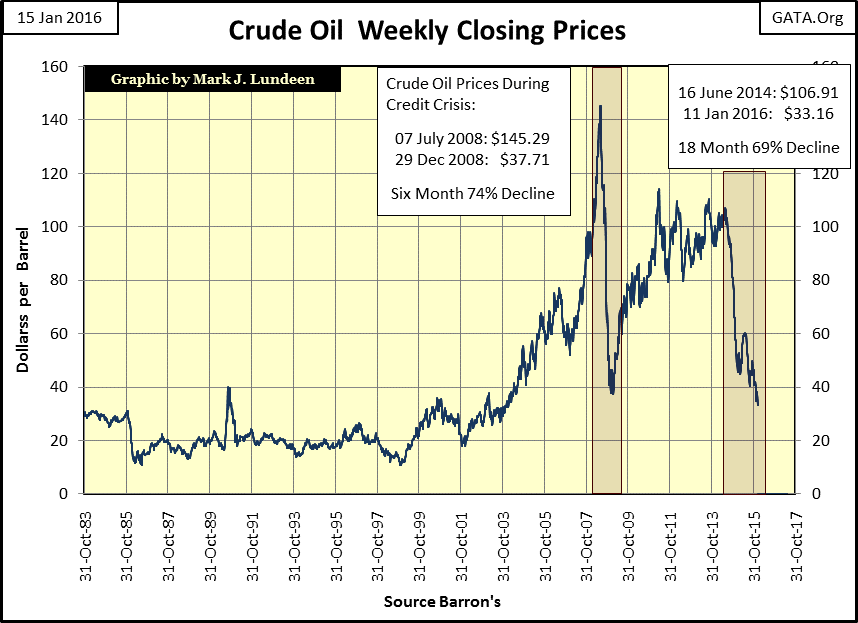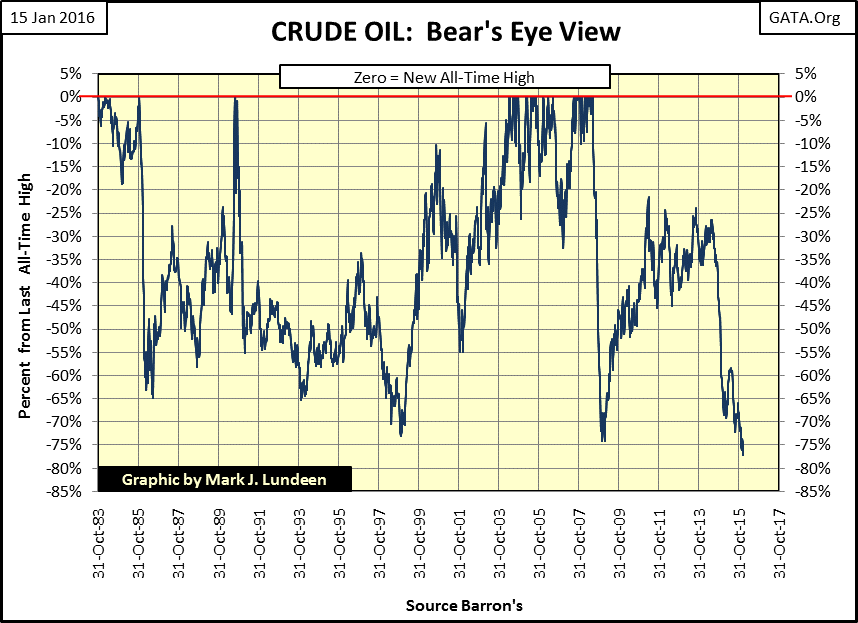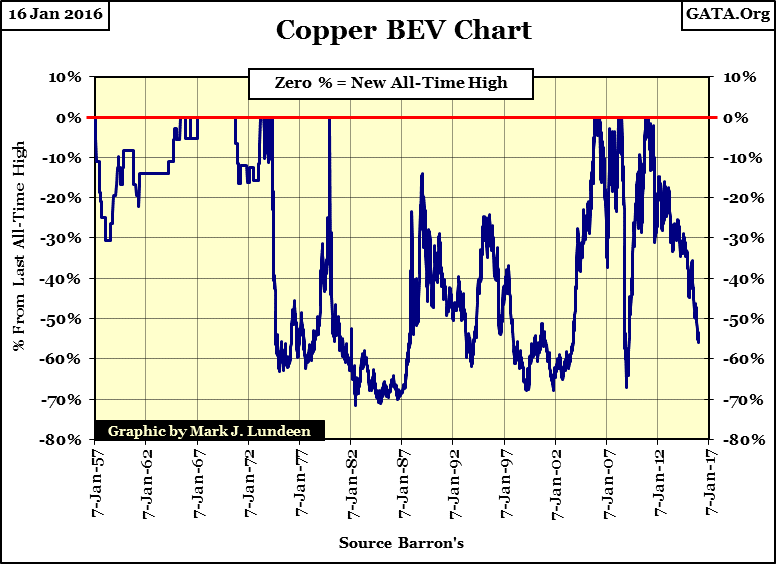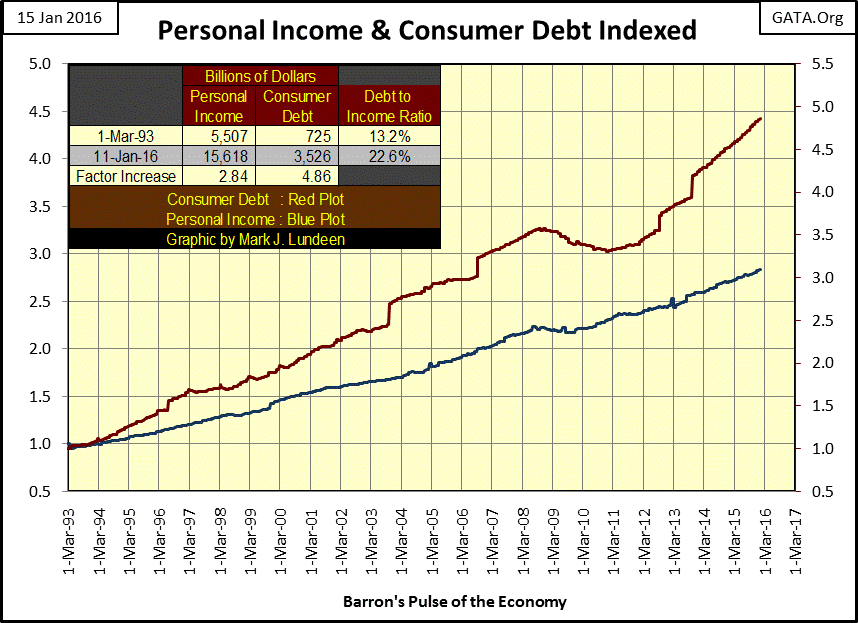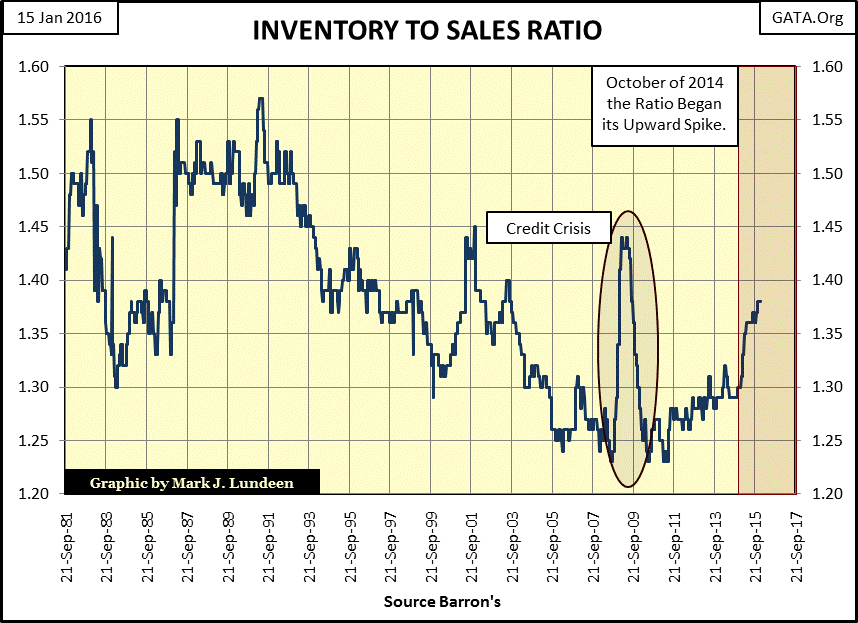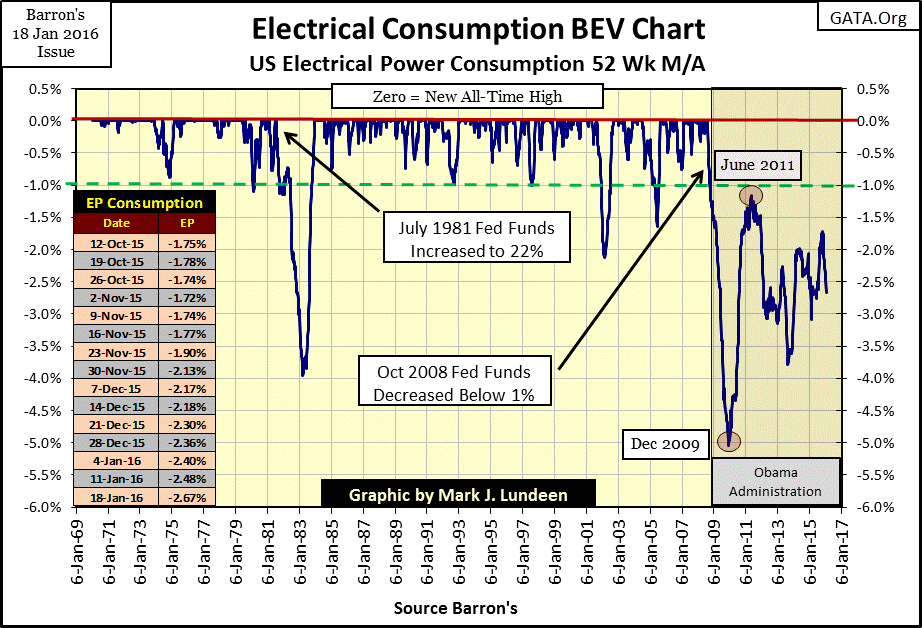Neither Stocks Nor Bonds Will Provide Protection In The Coming Market Correction
This week Mr Bear was on the job again, as seen in his report card below. At week’s close the 200 count is up to 12 and we see 3 Dow Jones 2% days in its eight day count. Since Charles Dow began publishing his stock average in 1885, you seldom see the Dow’s 200 count at twelve or its 8 count at three except when the stock market is under stress. Keep in mind that days of extreme breadth and volatility are rare market events. Unless the market is under pressure as it has been since the beginning of 2016; one just doesn’t see five extreme market events in ten trading days as seen below.
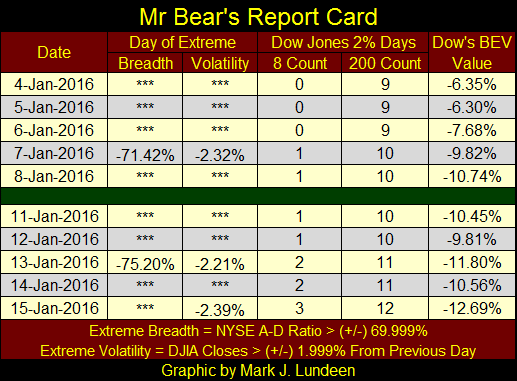
Don’t get me wrong, I’m not cheering for Mr Bear. He’s going to hurt everyone before he’s through. But understand that he’s a force of nature, something to be feared, a reason “policy makers” and “market experts” decades ago should not have put clueless college professors in charge of the money supply and credit creation at the Federal Reserve. But ever since Greenspan’s amazing bull market of the 1990s, a lot of damage has been inflicted on financial markets. Mr Bear now intends to see just how low he can drag the debt and equity markets before he’s ready to go back into hibernation.
This week the Dow Jones closed down 12.69% from its all-time high last May. That alone shouldn’t be a big concern. But for those in charge of this circus, the people who know exactly how the Dow Jones made it over 18,000 in 2015, it is. They know all market valuations today are based on nothing but hot air, and the financial markets they pumped up with monetary inflation are now deflating. Not that they intend to take a hands-off approach now in managing the market. Certainly not during an election year with so many baby boomers counting on their retirement accounts in the years to come. So stay tuned for some really idiotic “policy initiatives” to keep the markets inflated in the months to come.
Here’s the chart of the Dow Jones with its 52Wk highs and lows. Fourteen months after QE3 ended, the venerable Dow is making its second foray into the 15,000s; just 322 points from a new 52Wk Low at Friday’s close.
We could easily see the Dow Jones make a new 52 week low on Monday, although we may see a few positive days of extreme breadth and volatility first. Historically the stock market sees its largest daily advances during big bear markets. Daily advances of over 10% were not uncommon during the Great Depression. The credit-crisis bear also saw a few daily gains of 10%, which in no way signaled the end of the bear market. But you’d never know that by listening to the talking heads on CNBC. “Cheap stocks” in a big bear have a way of getting cheaper with the passage of time.
While the Dow Jones may be close to making a new 52Wk Low, companies trading on the NYSE have been doing exactly that as evident in my next chart. The NYSE 52Wk H-L Ratio hasn’t risen above 10% since the summer of 2014, and the most recent peak in the ratio was just 8.52% last March. Our current market decline has been a long time coming.
Here’s my working table for NYSE 52Wk Highs and Lows. To make things simple I have noted in English when the Dow Jones or the NYSE Ratio sees an up or down day. Since December 1st note how often the Ratio sees a down day on days the Dow Jones advances – not a sign of market strength. The “DJIA BEV” column lists the percentage decline the Dow Jones was from its May 2015 all-time high. The “Days BEV Zero” column gives how many trading days have passed since the Dow Jones’ last all-time high. The stunning thing about this table is how NYSE 52Wk lows have skyrocketed in the eight trading days since January 5th.
The most extreme day for the NYSE 52Wk Ratio during the credit-crisis bear occurred on 10 October 2008: -87.45%. That day the Dow Jones saw its first 40% decline since November 1974 and 2,891 of the 3,306 NYSE stocks trading that day made a new 52Wk Low. You should also note in the chart above that although the Dow Jones may have bottomed on 09 March 2009, for most of the companies trading on the NYSE the worst had already passed. Thanks to the Federal Reserve flooding the stock market with “liquidity” the Ratio recovered to down just -18.75% on March 09th with only 600 new NYSE 52Wk Lows.
It was a bleak week for the Dow Jones Total Market Group (DJTMG). No new 52Wk Highs but forty-five of seventy six groups reached new 52Wk Lows. The group’s average (#54) was -22.1% from its 52Wk High and only 3.42% from its 52Wk Low. Things are bleak for the group, but in big bear markets things have a way of becoming even bleaker.
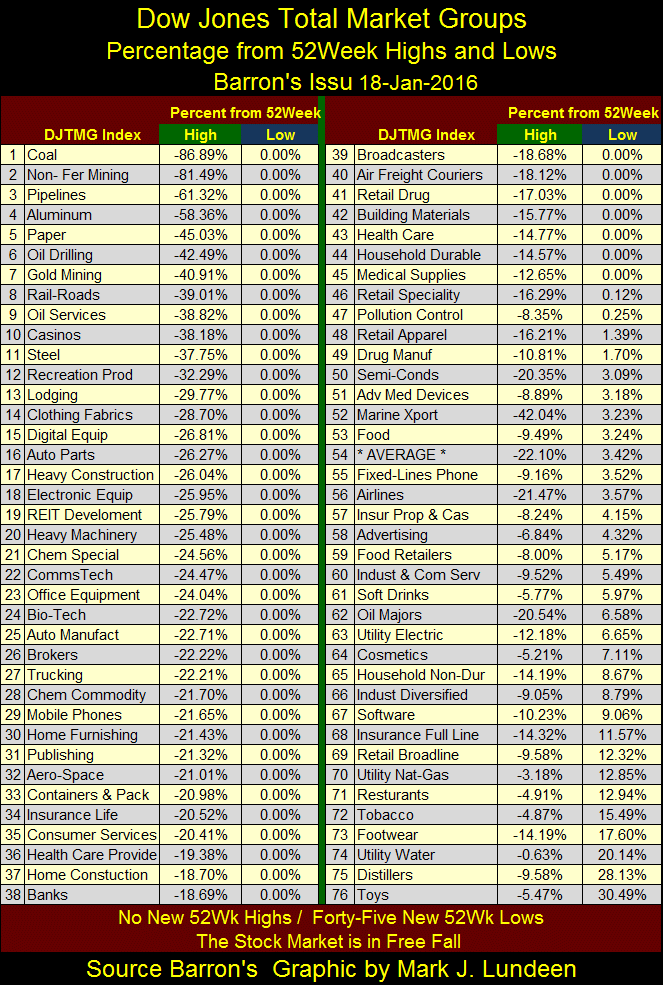
The table below makes two things clear:
- PPI & CPI (#22 & 24) are contrived government statistics that have nothing to do with commodity prices in the real world.
- To have made any money in the commodity markets over the past year one had to be holding a short position.
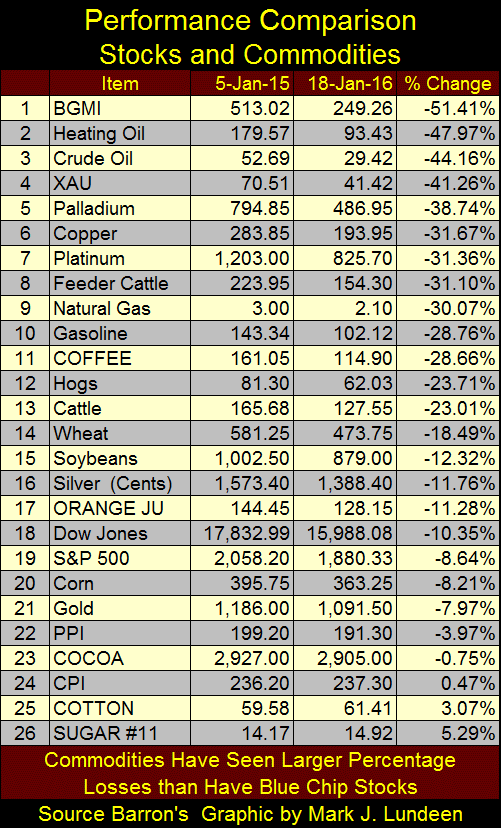
FYI: #20 above is Corn, not Com.
Declining commodity prices are having an impact on the larger economy. Debt laden energy companies, non-ferrous miners and family farmers are all in danger of defaulting on debts accumulated during better times. The share prices for Freeport-McMoRan, the huge copper-gold miner, have declined by 40% in the first few days of the New Year.
“Weak oil and copper prices are really amplifying Freeport's biggest issue, which is its gargantuan debt level. That debt recently resulted in the company's credit being downgraded by Fitch, while it was also put on review for a downgrade by Moody's.”
It was not so long ago everyone knew that higher, not lower energy costs were bearish for mining companies. As noted above, obviously someone changed that rule.
In a poison-pen article titled “Another One Bites the Dust” by a “progressive blogger” we see the environmental lobby’s reaction to this week’s bankruptcy of Arch Coal.
“Arch Coal has worked to gut basic environmental and public health protections and cheat miners out of benefits, all while cooking the climate and destroying complex ecosystems across the country. When history is written, Arch will not be cast as a good guy.”
I’m sure if I looked I could find a similar “progressive” article on the declining fortunes of the shale-oil companies. Obama ran for president promising to destroy the coal-mining industry, the only promise he made eight years ago he has managed to keep. The looming default by these coal companies on hundreds of billions of dollars of bonds seem to be of no concern to the environmental lobby; at least not yet. However before 2016 is through, they may regret the damage to their personal portfolios, company pension funds and life insurance companies should panic in the bond market breaks out. I wonder how many municipalities whose tax rolls depend heavily on the coal mining industry are also destined to default on their bonds?
Prices for basic commodities have been volatile for decades. Here are two charts for the price of a barrel of oil, in dollars and a BEV format. The two post 2000 declines in the price of crude oil are painfully apparent in the dollar chart below.
The Bear’s Eye View (BEV) chart below shows just how volatile the price of energy has been since 1983, when 60% declines in the price of oil have been the rule rather than the exception.
The story told above by the price for a barrel of oil is no different than for many other commodities listed in the table above. So why have declining commodity prices brought so much turmoil in the mining and energy industries since 2014?
Coal’s problems are unique. The environmental left whose control over the Federal Government’s Environmental Protection Agency (EPA) is total, declared a jihad against coal mining decades ago. The switch from coal to natural gas for domestic electricity production was a master’s stroke for them, one from which the coal industry will not recover. But for companies like Freeport their current problems can be placed at the table of central banks, like the Federal Reserve, who since the stock market’s 2000 top have continually “stimulated their economies” with monetary inflation.
Monetary inflation was accomplished by “injecting” credit into the banking system (“checkbook” money created out of nothing), whose members’ banks, at first found ready clients with sound balance sheets for bank loans at “attractive” rates. Credit was also injected indirectly into the bond market to fund mining projects that were not economically feasible at an unmanipulated market rate of interest or uninflated commodity prices. A significant percentage of this credit was used to finance projects that had no actual demand, such as cities in China where hundreds of thousands (millions?) of people could live, but still today remain unoccupied. In retrospect maybe it was a wise decision for China to invest in vacant cities for eventual occupation rather than hold all their dollar profits in US Treasury or Agency debt. But the demand for copper to wire these ill-advised cities and connect them to the electrical grid was huge – but now gone.
Look at copper’s BEV chart below. Twice in the 1970s copper prices declined over 60% from a previous all-time high. Did these declines result in any bond defaults by the large copper miners at the time? Not that I can recall. In 2002, with copper prices 68% below their last all-time high, Freeport was a thriving copper miner. But the “economic stimulus” central banking “injected” into the global economy eventually drove demand and the price for copper to new all-time highs with Freeport, and everyone else, taking full advantage of the cheap credit “injected” into the financial system. Now in 2016, with copper down 56% (and apparently still declining) from its last all-time high, most non-ferrous mining companies, like Freeport, are having problems servicing the debts they’ve taken on since 2002. Coal and Non Ferrous Miners are #1 & 2 in my table for the DJTMG for good reason.
The problem Freeport, China and American college students are now struggling with is best described by the Mogambo Guru below.
“Debt is the icky residue that remains after money is borrowed and spent.”
- Mogambo Guru, aka Richard Daughty
Understanding the exact problem the world at large now faces is no more complicated than this; corporations, governments and individuals on a global scale have borrowed and spent money created out of nothing by central banks freed from the constraints of the old gold standard. This money created out of nothing flowing from the banking system has allowed the world to consume far above its ability to repay banks and bond holders. Debt growth exceeding the income needed to service it is now a global phenomenon half a century after the Federal Government terminated the dollar’s last vestiges to the $35 an ounce gold standard.
As business and sales turn down, NYSE listed companies will begin laying off employees to reduce costs in an attempt to service their debts. That will result in a decrease in personal income in the chart below and an increase in personal bankruptcies and defaults on consumer debt. For a time the two plots in the chart below may diverge further than they already have. But it’s late in the game. They may begin to collapse in the not to distance future.
Just when this will happen I can’t say. However the Inventory-to-Sales Ratio plot below shows inventories (unsold goods) have increased faster than sales since 2011. This is par for the course before an economic decline and debt liquidation. Just this week Walmart announced it was closing 269 of its outlets, half of which are located in the US. No doubt the stores being closed were mostly chosen for their inability to move inventory out the door. Macy’s is having problems too.
I also expect a massive increase in unemployment. Unlike the spike in the ratio seen during the credit crisis, today it’s unlikely that a new round of massive monetary inflation (QE) will drive sales up, and bring the ratio down as swiftly as it did in 2009. It would more likely go into personal savings, or be used to pay down debt by a rapidly aging population.
Here’s the most popular chart I publish – EP’s BEV plot. Since Barron’s 02 November 2015 issue economic demand for EP has declined. The question I have is whether or not the current market decline will result in a second 5% decline in EP, as happened in December 2009. Maybe I got it backwards – the current decline in EP (economic contraction) might be leading the financial markets down.
This chart is simply amazing. The United States hasn’t seen demand for electric power increase to a new all-time high since August 2008; six months before Obama became president. There is something very wrong with the economy that is not being addressed – too much debt. More monetary inflation can’t fix that.
No doubt about it; the years to come will prove interesting, if not enjoyable. After decades of “financial engineering” by Wall Street’s derivative salesmen something really bad is coming our way. Holding some gold and silver bullion to guard against counterparty failure seems the logical way to provide some protection for what is coming our way. That done, some exposure to the precious metal miners is warranted too.
Mark J. Lundeen






